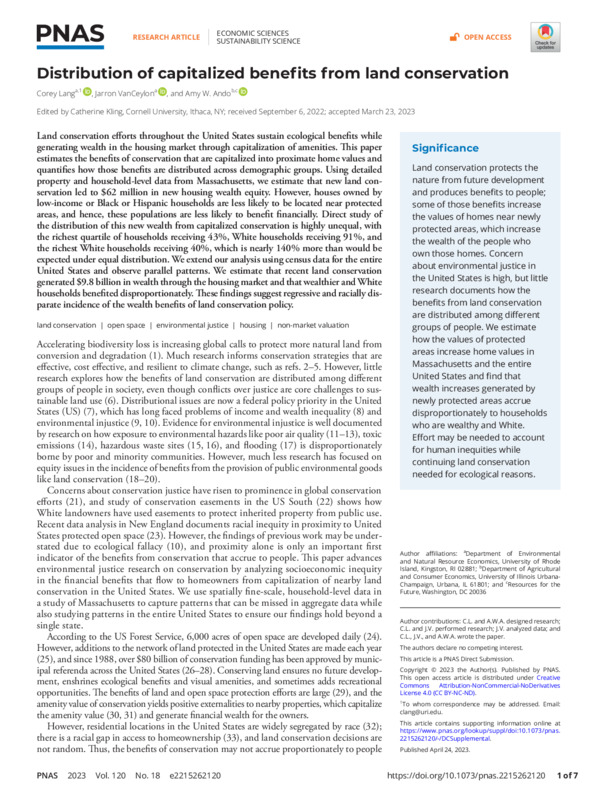Distribution of Capitalized Benefits from Land Conservation
Item
-
Title
-
Distribution of Capitalized Benefits from Land Conservation
-
Repository
-
Proceedings of the National Academy of Sciences of the United States of America
-
Date Created
-
March 2023
-
Creator
-
Corey Lang, Jarron VanCeylon, Amy W. Ando
-
Description
-
Lang et al. study the way in which conservation benefits are unevenly distributed. Their findings show that benefits for conservation are disproportionately in the favor of white wealthy households in Massachusetts. These findings, and other scholarly work that demonstrates histories of displacement, call into question the culture of conservation in Loudoun County due to the inequalities within conservation easements - the most common method of conservation used by Loudoun.
-
Index/Partial Transcript
-
Abstract:
Land conservation protects the nature from future development and produces benefits to people; some of those benefits increase the values of homes near newly protected areas, which increase the wealth of the people who own those homes. Concern about environmental justice in the United States is high, but little research documents how the benefits from land conservation are distributed among different groups of people. We estimate how the values of protected areas increase home values in Massachusetts and the entire United States and find that wealth increases generated by newly protected areas accrue disproportionately to households who are wealthy and White. Effort may be needed to account for human inequities while continuing land conservation needed for ecological reasons., Land conservation efforts throughout the United States sustain ecological benefits while generating wealth in the housing market through capitalization of amenities. This paper estimates the benefits of conservation that are capitalized into proximate home values and quantifies how those benefits are distributed across demographic groups. Using detailed property and household-level data from Massachusetts, we estimate that new land conservation led to $62 million in new housing wealth equity. However, houses owned by low-income or Black or Hispanic households are less likely to be located near protected areas, and hence, these populations are less likely to benefit financially. Direct study of the distribution of this new wealth from capitalized conservation is highly unequal, with the richest quartile of households receiving 43%, White households receiving 91%, and the richest White households receiving 40%, which is nearly 140% more than would be expected under equal distribution. We extend our analysis using census data for the entire United States and observe parallel patterns. We estimate that recent land conservation generated $9.8 billion in wealth through the housing market and that wealthier and White households benefited disproportionately. These findings suggest regressive and racially disparate incidence of the wealth benefits of land conservation policy.
-
Research Themes
-
Conservation Easements
Culture of Conservation
Racial inequalities in conservation
Tax benefits of conservation easements
Displacement
-
Researcher Name
-
Jacob Connelly
-
Bibliographic Citation
-
Lang, Corey, Jarron VanCeylon, and Amy W. Ando. “Distribution of Capitalized Benefits from Land Conservation.” Proceedings of the National Academy of Sciences of the United States of America 120, no. 18 (March 2023): e2215262120. https://doi.org/10.1073/pnas.2215262120.
 Va.’s Reliance on Tax Credits for Land Conservation Is ‘certainly Not Equitable,’ Review Finds
Va.’s Reliance on Tax Credits for Land Conservation Is ‘certainly Not Equitable,’ Review Finds
